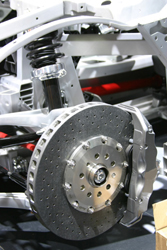Breaking news for the auto brake industry
The invention of steel, and later on of stainless steel, has made it possible to construct long bridges and skyscrapers. The physical and chemical properties of this iron alloy, its hardness, ductility and tensile strength make it extremely useful. Steel is also widely used in the automotive and aerospace industry. Magnesium alloys have almost the same physical and chemical properties as steel. These alloys are much lighter however but are unfortunately corrosion susceptible. The NANOMAG project has succeeded in developing novel nanocomposite coating methods for protecting magnesium alloys from corrosion and abrasion. With minimised corrosion susceptibility, all the benefits from the alloys' reduced weight can be fully exploited. Elaborate plasma techniques were used for the deposition of protective coatings.Tarabusi a Spanish NANOMAG project partner, initially cast a magnesium alloy piston. Casting is a well known manufacturing technique in which the magnesium alloy, in liquid form, is shaped by a mould. The cast piston was subsequently treated with keronite, a hard coating, for corrosion and abrasion protection. The piston was then coated using Plasma assisted physical vapour depostion (PAVD)with a nitride layer. Finally, the new piston was assembled in a reciprocating compressor in a commercial vehicle's braking system and extensively tested with over a thousand hours of running tests. The automotive industry has a keen interest n magnesium alloys for mechanical parts. The use of these alloys results in production of lighter, less energy-consuming vehicles. The new piston is currently available for demonstration.







